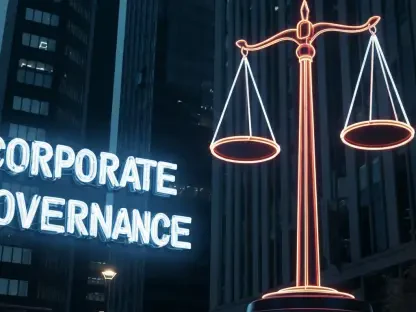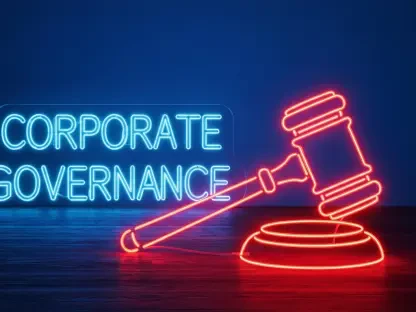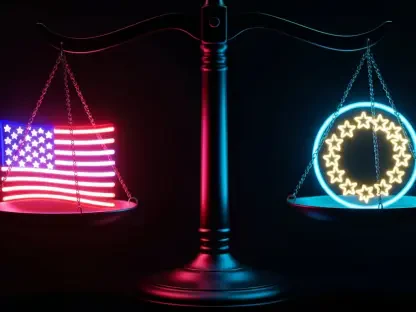In a landscape where federal regulations once provided a predictable framework for industries across the United States, a seismic shift has occurred that is reshaping the very foundation of administrative law, aligning perfectly with an aggressive push to slash regulations under the current Trump Administration. This landmark Supreme Court decision in 2024 has dismantled decades of precedent, sending shockwaves through corporate boardrooms and compliance offices, and raising critical questions about how businesses can navigate an era of unprecedented uncertainty. With the balance of interpretive authority now tilted away from federal agencies, the stage is set for a deeper exploration of how this legal transformation is fueling a deregulatory wave that could redefine industry standards for years to come.
Understanding the Context: The Supreme Court’s Loper Bright Decision
The Supreme Court’s ruling in Loper Bright Enterprises v. Raimondo in 2024 marked a historic turning point by overturning the Chevron doctrine, a 1984 precedent that allowed federal agencies to interpret ambiguous statutes with judicial deference. This long-standing principle had provided agencies significant leeway to shape regulations based on their expertise, often serving as a stabilizing force for businesses reliant on consistent regulatory guidance. By eliminating this deference, the court has shifted the responsibility of statutory interpretation squarely to the judiciary, empowering judges to determine the singular, most accurate meaning of laws without leaning on agency input.
This shift fundamentally alters the dynamics of administrative law, stripping agencies of a once-critical tool for policymaking and placing greater authority in the hands of courts. Legal scholars argue that while the intent may be to ensure precision in statutory application, the immediate effect is a patchwork of interpretations that vary by jurisdiction. The unpredictability this creates is a stark departure from the prior landscape, where Chevron deference often smoothed over ambiguities and fostered a sense of regulatory continuity for industries.
Prior to this decision, the Chevron doctrine played a pivotal role in maintaining a semblance of order in the complex interplay between federal regulations and industry compliance. It offered a buffer against constant legal challenges by prioritizing agency expertise, thus providing businesses with a clearer path to follow. Now, with that buffer removed, the regulatory environment stands at a crossroads, vulnerable to rapid shifts driven by judicial discretion rather than established agency practice, setting the stage for significant challenges ahead.
The Trump Administration’s Deregulatory Agenda
Key Policies and Directives
Under the Trump Administration, the drive to dismantle federal regulations has gained unprecedented momentum, with specific actions capitalizing on the recent judicial shift. Executive orders issued in early 2024 directed federal agencies to scrutinize and identify regulations that conflict with the new legal standard set by the Supreme Court, pushing for their swift repeal. Additionally, presidential memoranda and guidance from the Office of Management and Budget have established accelerated timelines for review and elimination of rules deemed outdated or unlawful, often within mere weeks.
A notable tactic in this deregulatory blitz is the bypassing of traditional rulemaking safeguards under the Administrative Procedure Act. By invoking the “good cause” exception, the Administration has sidestepped the time-intensive notice-and-comment process, allowing for rapid policy rollbacks without public input. This approach, while efficient for the government’s objectives, has sparked concern among legal experts who warn of the erosion of procedural fairness and the potential for hasty, poorly vetted decisions that could disrupt industry operations.
At its core, the Administration’s agenda reflects a broader mission to reduce the regulatory burden on businesses, viewing federal oversight as a hindrance to economic growth. This philosophy drives initiatives across multiple sectors, from environmental protections to labor standards, aiming to reshape the relationship between government and industry. The scale and speed of these efforts signal a deliberate strategy to redefine the regulatory landscape in favor of minimal oversight, raising questions about long-term stability.
Alignment with Loper Bright
The Loper Bright decision has emerged as a critical legal foundation for the Trump Administration’s deregulatory ambitions, creating a powerful synergy between the judiciary and executive branches. By removing the obligation for courts to defer to agency interpretations, the ruling provides judicial backing for challenging and overturning longstanding regulations, aligning seamlessly with the Administration’s goal of slashing federal oversight. This legal shift essentially offers a green light to expedite policy changes that might have previously faced significant hurdles.
Experts in administrative law have noted that this alignment dramatically accelerates the pace of deregulation, as agencies can now point to the Supreme Court’s stance to justify retreating from prior positions. The combined effect introduces rapid policy shifts that leave little time for industries to adapt, amplifying the sense of instability. Commentary from legal analysts suggests that this partnership between judicial precedent and executive action marks a turning point in how quickly regulatory frameworks can be dismantled.
The impact on regulatory stability is profound, as the dual forces of a transformative court ruling and aggressive executive directives converge to create an environment of flux. Businesses once reliant on consistent agency guidance now face a reality where rules can be invalidated overnight, either through court challenges or administrative fiat. This dynamic underscores the urgency for industries to reassess their compliance strategies in light of a fundamentally altered playing field.
Challenges in the Regulatory Landscape Post-Ruling
The aftermath of the Loper Bright decision, compounded by the Trump Administration’s policies, has introduced significant obstacles to the regulatory landscape, chief among them being judicial inconsistency. With interpretive authority now resting with courts rather than agencies, rulings on similar issues can differ widely across jurisdictions, creating a fragmented legal environment. This lack of uniformity poses a direct challenge to businesses operating in multiple regions, as they grapple with conflicting standards and expectations.
For regulated entities and compliance professionals, the uncertainty stemming from non-uniform statutory interpretation is a pressing concern. Without a cohesive framework to guide decision-making, companies face heightened risks of non-compliance, even when acting in good faith. The early stages of post-ruling case law offer little clarity, as courts across the country are still navigating their newfound interpretive power, often yielding divergent outcomes that complicate planning and implementation for industries.
Navigating this volatile environment requires innovative strategies, such as preparing for increased litigation to challenge or clarify ambiguous rulings. Advocacy for more definitive judicial guidance from higher courts could also help mitigate inconsistency over time. Additionally, businesses may need to invest in robust legal counsel to anticipate and address jurisdictional variances, ensuring they remain agile in a landscape where the rules of engagement are constantly shifting.
Impact on Corporate Compliance and Federal Agencies
The direct effects of the Loper Bright ruling and the accompanying deregulatory push are keenly felt in corporate compliance, placing new demands on Chief Compliance Officers. These professionals must now vigilantly monitor the status of finalized rules, as many are vulnerable to sudden invalidation through judicial or administrative action. Adapting risk assessments to focus on statutory foundations rather than potentially transient regulations has become a critical priority to safeguard against unforeseen disruptions.
Sector-specific impacts further illustrate the breadth of this transformation, with agencies like the Environmental Protection Agency facing challenges to long-standing rules on issues such as water safety standards. In healthcare, court reinterpretations of policies by bodies like the Centers for Medicare & Medicaid Services have upended established practices, forcing providers to reevaluate compliance frameworks. These examples highlight how the ripple effects of deregulation and judicial shifts touch diverse industries in unique but equally disruptive ways.
Certain exceptions exist, such as the Treasury Department’s Office of Foreign Assets Control, which retains a degree of deference due to its national security mandate. However, even this agency encounters scrutiny under the new legal paradigm, facing challenges in areas like cryptocurrency sanctions enforcement. This nuanced landscape underscores the complexity of compliance, where some sectors experience sweeping change while others navigate more subtle, yet still significant, adjustments to their regulatory obligations.
Future Implications for Regulation and Industry
Looking ahead, the combined influence of the Loper Bright decision and Trump’s deregulatory efforts suggests a sustained period of upheaval, with potential increases in litigation as stakeholders challenge agency actions or seek clarity on statutory meanings. State-level responses may also emerge as a counterbalance, with local governments stepping in to fill gaps left by federal rollbacks, further complicating the regulatory mosaic. This trend points to a fragmented future where national consistency remains elusive.
Emerging practices among compliance professionals include a sharper focus on statute-based controls to anchor operations in more stable legal ground, reducing reliance on mutable agency guidance. Reevaluating third-party contracts and vendor relationships is another priority, as long-term commitments tied to specific regulations risk becoming obsolete. These adaptive measures reflect a broader industry shift toward resilience in the face of ongoing uncertainty.
Global economic conditions and domestic policy fluctuations will likely continue to shape the regulatory environment, with volatility expected to persist as courts and agencies adjust to their redefined roles. Forecasts indicate that industries must prepare for a prolonged period of adjustment, balancing the need for flexibility with the pursuit of operational stability. The interplay of these factors suggests that the path forward will be anything but straightforward, demanding vigilance and strategic foresight from all stakeholders.
Navigating a Transformed Regulatory Era
Reflecting on the profound changes brought by the Loper Bright ruling and its alignment with the Trump Administration’s deregulatory agenda, it becomes evident that the U.S. regulatory framework has undergone a dramatic transformation. The shift in interpretive authority from agencies to courts, coupled with executive actions to dismantle federal oversight, has created a landscape of uncertainty that challenges industries at every turn. Compliance professionals and regulated entities find themselves at the forefront of navigating this complex terrain, grappling with inconsistency and rapid policy shifts.
Looking back, the discussions around judicial inconsistency and sector-specific impacts have highlighted the scale of adaptation required. Yet, moving forward, actionable steps emerge as critical for mitigating risks, such as embedding compliance programs with a strong statutory foundation to withstand sudden regulatory changes. Advocating for procedural safeguards during deregulation efforts also stands out as a necessary measure to ensure fairness and transparency in policy rollbacks.
Ultimately, the path ahead calls for a proactive stance, with industries encouraged to foster collaboration with legal experts to anticipate judicial trends and build robust contingency plans. Investing in technology to track regulatory developments in real-time offers another avenue to stay ahead of the curve. These strategies, grounded in adaptability and foresight, provide a roadmap for thriving in an era where the only constant is change itself.









